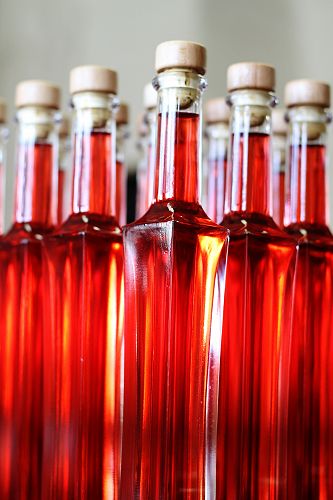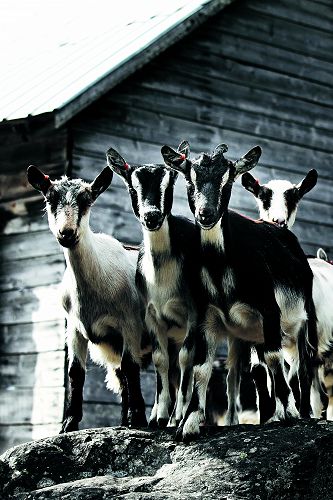
Östersund, UNESCO City of Gastronomy
It is late April or early May and the thick ice from Lake Storsjön is breaking up.
Finally the ice vanishes and nature
is ready for next season. The first grass of the season grows so quickly it is
nearly transparent – an almost shiny light green. The area around the lake is
very good for grass. There is plenty of rain and never drought. This grass is
not a place where you play golf or have your garden table. It is important feed
for cows, sheep and goats – the animals that give us both meat and milk. In the
summer the animals can graze on the pasture, and in the winter they get the
grass and clover as silage stored from the summer.
The farmers have a very short time for the sowing season. They have to be quick to utilise the intense and very short growing season. In June all flowers and plants grow faster than further south, because it never gets dark. In August or September it is time to harvest before the snow arrives in November.
The cold
temperature, the rain and snow, no dangerous animals, long distances to other
cities, very few people, without any large industries – all of this makes
Jämtland, and Östersund, a special place to live. It has been necessary to trust
people and to take care of the natural resources that are here. All resources
are essential, you have to take care of both people and what nature gives you. Many
people pick berries and mushrooms in the autumn. Moose hunting is an important tradition for
many in the area. Tourists have been visiting Jämtland for well over a hundred
years. Visitors first came to the area for the clean air, then for the skiing,
and now they come for the mountains and the special food.
Rural-Urban
Despite their distance from large cities, Östersund and Jämtland are part of
the wider world and get all the advantages and disadvantages of globalisation. The world is now a place where the price of a litre of milk is decided far
from its area of production and the farmers are dependent on soy or other
protein-rich animal feed sourced from other continents. Specialisation has gone
very far in many parts of the world.
Competition in Sweden and in many other countries forces farmers to specialise in just a few crops, or even in just one part of the food chain. The incentive to go mono-cropping or to specialise is to cut production costs, even though the prices you receive for your produce are not catching up. Farmers around the world have been very effective in this work. Fewer and fewer farmers remain today and they have larger and larger areas with just one crop.
They
have managed to cut costs. Apparently economical transportation has made it
possible for people to afford and eat all kind of foods no matter where they
are produced. Can we afford this cheap food? It actually has a very high price
tag, because we have externalised the costs of food. Who should pay farmers
that get sick or even die, poisoned by pesticides? Who should pay for the loss
of biodiversity – for the flowers and birds that are not found any more? Who
should pay for the pesticides in the groundwater? Who should pay for the greenhouse gases that warm our planet? Who should pay for the water that you could once use for irrigation, but that now has disappeared?
We all
pay the price for the unsustainable food system.
We pay
the price by eating low-quality food without any identity or taste, by eating
food in loneliness from ugly containers, by having boring jobs where people are
like machines that make the same thing over and over again. Some pay a very
high price with their lives, by getting very sick from pesticides or by losing
their job. Others are paying by losing their hope for the future if they can’t
continue farming as generations of their forbears have before them.
All over the world we see that people want something else. The food developing line can take another path. There is great interest in buying organic products, fair trade products and artisan products, as well as buying directly from farmers. The number of organic farms and sales has increased markedly in many countries. More people in cities are also starting to grow food together. Chefs are making more products themselves and finding local products to serve. Regions and towns are interested in their food specialties. They like to preserve and develop their gastronomy, for tourists and local people. Cities come together in networks like UNESCO Creative Cities of Gastronomy – a network of cities that want to develop and show their food specialties. Östersund is working with food producers by educating the producers, by offering tourists food experiences and by finding ways to offer local food at schools.
Time is
short to preserve and develop what we still have rather than destroy more land,
animals or people. We can develop and support new initiatives and the ones
already here. We have a chance to build new relationships with people and
nature. We have a great chance to make a difference right here, right now.
We enjoy food
Östersund
invited all the UNESCO Creative Cities to the Annual Meeting 2016 – a meeting
to gather all the cities with creativity as a driving force in development. The
meeting was a celebration of all food producers and creative people in
Jämtland. It showed the delegates, and all the people of Östersund, that we have
creative food producers, talented musicians, rich traditions and creative ways
to enjoy them. It was a platform for the city of Östersund to bring the world to
us, to get inspiration and to develop our town, to get new creative ideas – to have
the chance to share a nice meal together with new friends.
Gallery








